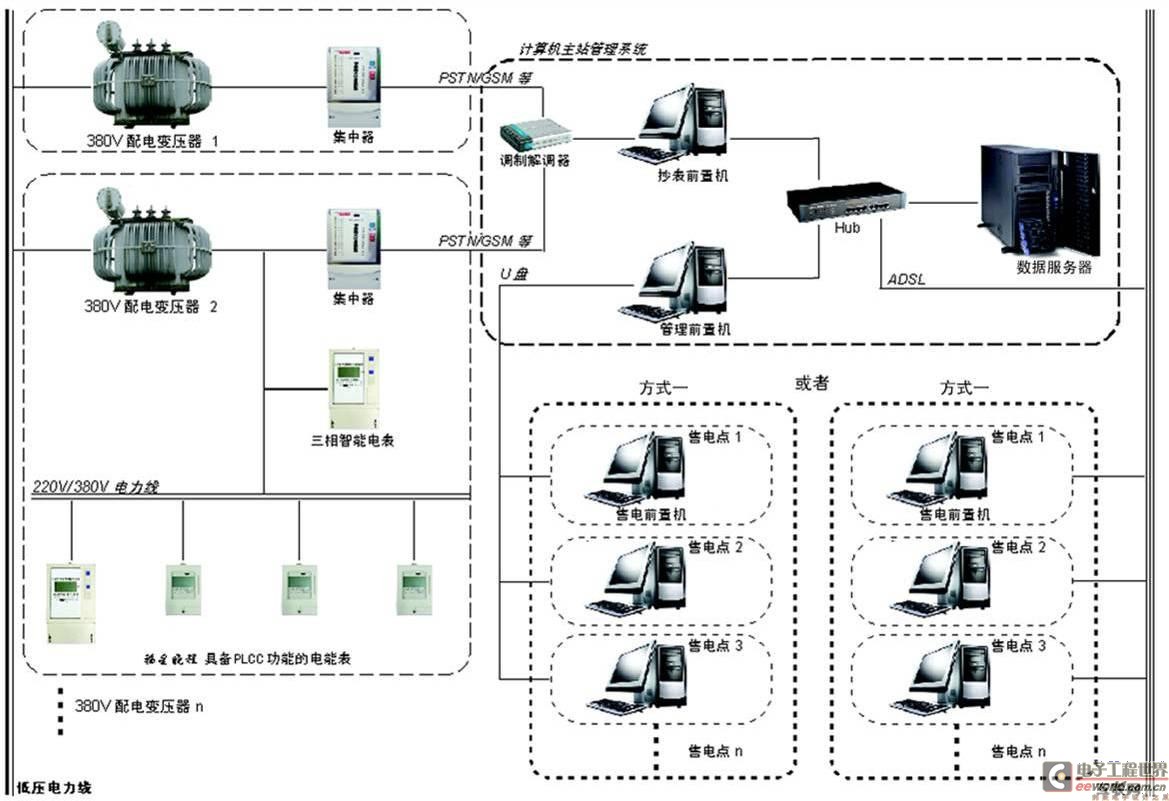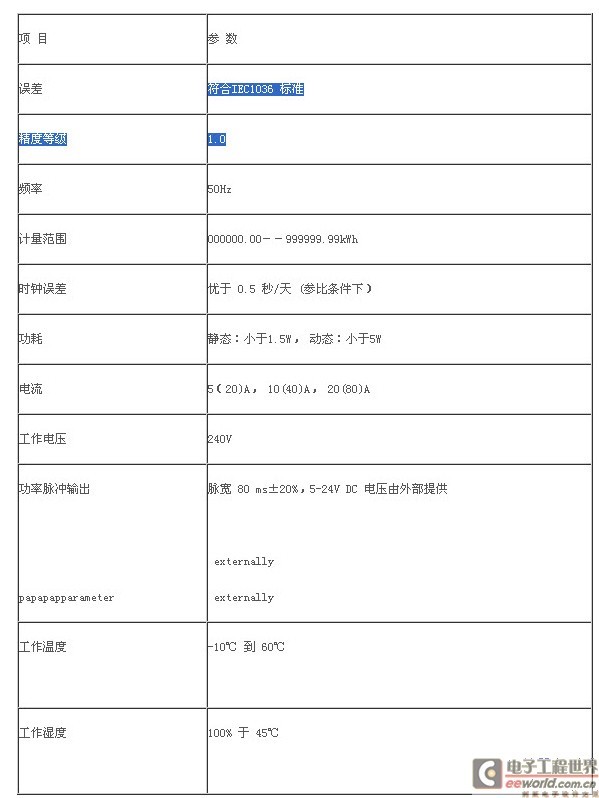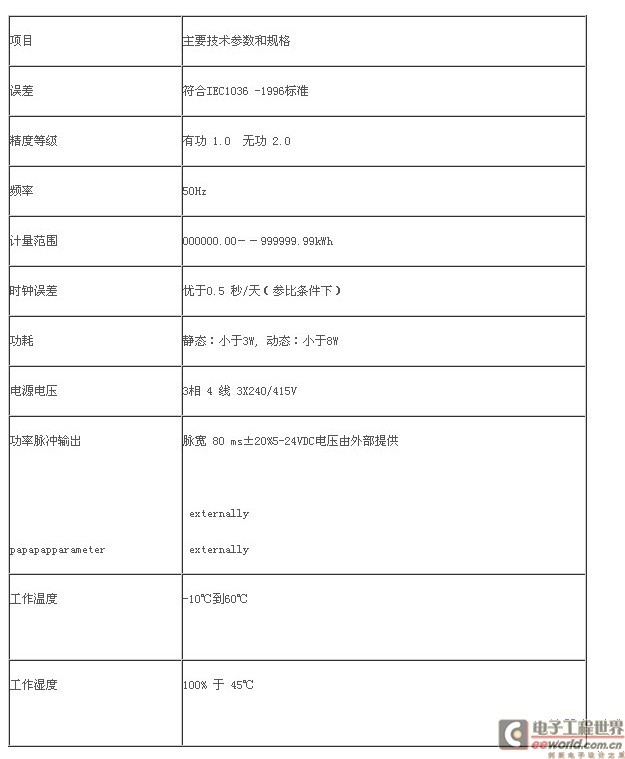The first part of the current local energy metering status 1.1 The current energy metering status a) The power companies are still mainly using mechanical energy meter and low-cost electronic meter for energy metering, the accuracy level is mostly 2 b) due to stealing Phenomenon and the distribution of power grid lines, the line loss rate is high, some individual areas are estimated to be more than 20%. Because mechanical energy meters cannot accurately calculate line losses, almost all data is "estimated".
c) It is difficult to find and locate the line loss position because there is no monitoring between the master table and the sub table.
d) The traditional post-paid system implemented throughout the country makes tax collection more difficult.
e) Manual meter reading leads to frequent errors and waste of time and resources. And because meter readings are not performed at the same time, it is difficult to perform accurate post-electric energy data analysis and line loss analysis.
1.2 Problems to be solved urgently a) Improve the accuracy of the meter b) Reduce the line loss and locate the location of the line loss c) Accurately recover the electricity cost in time d) Reduce the cost of meter reading Part 2 Introduction of the low voltage power line carrier automatic meter reading system 2. 1 System Function Description a) In order to ensure the timely recovery of electricity charges, the power company can remotely power off the arrears user at the main station b) Use high-precision full-electronic energy meter c) Use power line carrier long-distance communication technology to carry out user power usage Monitoring to prevent users from stealing electricity.
d) Accurately locate the line loss position by analyzing the data of the master table and the sub-table
2.2 The system diagram is shown below:

From the above figure, the low-voltage power line carrier automatic meter reading system includes three parts:
a) Computer Master System: Used to collect, store, and analyze data. Generally this unit is located in the office of the power company's management department – ​​for example, the meter reading center in the power sector in District xx, New Delhi, India. The main hardware includes a data server (for data retention), a management front-end (for management data), and a meter reading front-end (for reading back data and storing it in the data server). This system is connected by the local area network and connected to the internet to communicate data with each point of sale.
b) Data Concentrator Unit: Installed on the low voltage side of the transformer 240/415V. The communication between the data concentrator unit and the master station can be realized through PSTN, GSM, GPRS, RS232 or CDMA, while the communication between the concentrator and the meter is achieved through low-voltage power line carrier technology.
c) Terminal Unit: An electronic multi-function meter developed independently for our company. They transmit data to the concentrator via low-voltage power line carrier communications.
The electricity sale system is independent of the automatic meter reading system. It can be located at the bank or at any other point of sale (PoS). Through the Internet, the point of sale data can be transmitted to the main station. In addition, this system is also a real-time online system. Sales information at the point of sale is also transmitted to the main station in real time over the Internet. Users can choose their own point of sale to purchase electricity.
The third part of the implementation details 3.1 payment details (in the existing system as an example):
All meters will freeze data at 00:00 on the first day of the month, and then the concentrator will automatically read and store this data for the next 5 days. On the fifth day of each month, the master station reads these frozen data from the concentrator, generates electricity bills, and then prints automatically by the meter reading front-end machine.
The electricity bill must be delivered to the user by the 10th of each month. The user can make the payment to the bank within the time of the end of each month from the date of receipt of the bill. If the user does not make the payment in time (the payment information can be verified in the main station software), the power company can give the user a written notice and urge it to pay within 5 days of the grace period. If the user has not paid within 5 days, the power company can remotely power off the user at the main station until it can make up the amount payable and then resume power.
3.2 Stealing Electricity and Penalty Measures Stealing electricity requires changing the communication connections at the power line at the foot of the table. In some cases, even if the meter has a wrong phase sequence or reversed direction, the meter can still be accurately measured. However, due to the change of the meter connection, low-voltage power line carrier communication will be stopped, and it is easy to detect and locate such behavior at the master station. The power company can check the user's line to determine whether the interruption was due to power theft or meter failure. In other cases, even if a stealing user changes the way the meter is connected to steal power, the meter can still communicate normally. This kind of situation compares the total table data with the sum of the data of each sub-table to determine the approximate location of the electricity theft occurred. Then, by manually checking the lines, the electric company can easily locate such line losses or steal the electricity.
The specific penalty measures are decided by the power companies themselves.
The fourth part of the technical specifications of a meter, single-phase energy meter FD129
FD129 is a multi-functional measurement SOC product PL3201 based on independent research and development of our company and possessing intellectual property rights.
1. Basic technical parameters

2. The main function
Metering parameters:
# Active energy: Reversal is still accurately metered and has a reverse error indication.
# Reactive power
# Energy Data Freeze: Monthly electricity data freeze date can be preset for printing monthly electricity bills.
# Real time clock and calendar: Automatically adjust leap year, external battery can maintain 10 years of life in case of power failure.
# Active energy pulse output: used for calibration, power acquisition, passive isolated output port
# Communication function: support infrared and low voltage power line carrier communication
# Display function:
· LCD display 6-bit integer, 2 decimal places
·Automatically display
·You can set items to be displayed by infrared handheld meter reading equipment
· 4 seconds for each display item
The display items are:
·date
·time
·Electric meter address
·Constant meter
Active energy
Reactive power
·Power on LCD display test
# Data storage: After power off, all data can be maintained for more than 10 years.
# Protection level: IP51
3. Communication function
The FD129 supports the use of infrared and low-voltage power line carrier communications for data transmission. Low-voltage power line carrier communication is used for remote automatic meter reading and monitoring of meter operation status. The main station can analyze the theft and line loss last month. Infrared communication is used for local meter reading and setting meter parameters.
The following is a brief description of the functions of various communication types:
a) Low-voltage power line carrier communication
- Meter reading: copying frozen data or real-time copying
- Freeze data: 12 months of active energy
- Tap (refer to real-time reading of the current data item of each meter): Current active, 12 months of active frozen data, meter constant, date, automatic freeze date, and balance.
b) Infrared communication
- Meter reading: Use the PDA to retrieve current active, reactive, 12-month active frozen data, meter constants, date and time, and automatic freeze date.
- Meter settings: table number, password and freeze date.
Second, three-phase multi-function meter FD130
FD130 is a three-phase multi-function electric energy meter based on PL3223 (three-phase multi-function metering chip) and PL3201. It also has low-voltage power line carrier communication function.
1. Basic technical parameters

2. The main function
Metering parameters:
# Active energy: Reverse is still accurately metered and has a reverse error indication.
# Reactive power
# Energy Data Freeze: Monthly electricity data freeze date can be preset for printing monthly electricity bills.
# Real time clock and calendar: Automatically adjust leap year, external battery can maintain 10 years of life in case of power failure.
# Active energy pulse output: used for calibration, power acquisition, passive isolated output port
# Communication function: support infrared and low voltage power line carrier communication
# Display function:
· LCD display 6-bit integer, 2 decimal places
·Automatically display
·You can set items to be displayed by infrared handheld meter reading equipment
· 4 seconds for each display item
The display items are:
·date
·time
·Electric meter address
·Constant meter
Active energy
Reactive power
·Power on LCD display test
# Data storage: After power off, all data can be maintained for more than 10 years.
# Protection level: IP51
4. Communication function
The FD130 supports infrared and low-voltage power line carrier communications for data transmission. Low-voltage power line carrier communication is used for remote automatic meter reading and monitoring of meter operation status. The main station can analyze the theft and line loss last month. Infrared communication is used for local meter reading and setting meter parameters.
The following is a brief description of the functions of various communication types:
a) Low-voltage power line carrier communication
- Meter reading: copying frozen data or real-time copying
- Freeze data: 12 months of active energy
- Tap (refer to the real-time reading of the current data item of each meter): Current active, 12 months of active frozen data, meter constant, date, automatic freeze date, and balance.
b) Infrared communication
- Meter reading: Use PDA to retrieve current active, reactive, 12-month active frozen data, meter constants, date and time, and automatic freeze date.
Meter settings: table number, password and freeze date.
Guangzhou Fengjiu New Energy Technology Co.,Ltd , https://www.flashfishbatteries.com